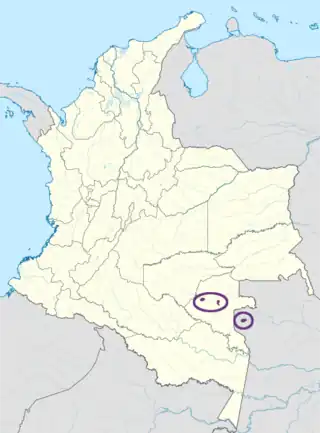| Carapano | |
|---|---|
| Mõxtã | |
| Native to | Colombia, Brazil |
Native speakers | 500 (2012)[1] |
Tucanoan
| |
| Language codes | |
| ISO 639-3 | cbc |
| Glottolog | cara1272 |
| ELP | Carapana |
 | |
Carapano (Karapanã, Carapana-tapuya, Möxdöá) is a Tucanoan language of Colombia and Brazil.
Phonology
Carapano has 11 consonants, plus 3 tones: high, medium and low.[2]
| Bilabial | Alveolar | Palatal | Velar | Labial–velar | Glottal | |
|---|---|---|---|---|---|---|
| Plosive | p b | t d | k ɡ | |||
| Sibilant fricative | s | |||||
| Non-sibilant fricative | h | |||||
| Approximant | j | w | ||||
| Tap/flap | ɾ |
It also has 6 vowels and their nasalized forms.[2]
| Front | Central | Back | |
|---|---|---|---|
| Close | ĩ i | ɨ̃ ɨ | u ũ |
| Close-mid | ẽ e | o õ | |
| Open | ã a |
References
- ↑ Carapano at Ethnologue (25th ed., 2022)

- 1 2 Metzger, Ronald; Metzger, Lois (1973). "Fonolog'ia del carapana": 121–132.
{{cite journal}}: Cite journal requires|journal=(help)
This article is issued from Wikipedia. The text is licensed under Creative Commons - Attribution - Sharealike. Additional terms may apply for the media files.